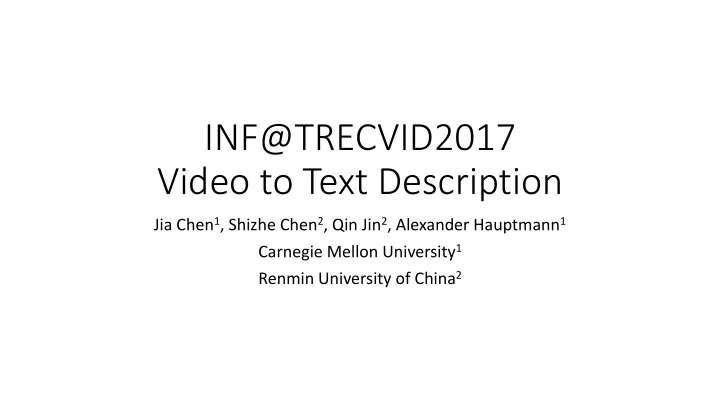

INF@TRECVID2017 Video to Text Description Jia Chen 1 , Shizhe Chen 2 , Qin Jin 2 , Alexander Hauptmann 1 Carnegie Mellon University 1 Renmin University of China 2
Main focus in this year: cross-dataset generalization • Last year: • As the video caption pilot task provides no training captions for videos, we treat it as an opportunity to test the generalization ability of the caption models. • This year: • We found that the performance of caption model begins to saturate within one dataset by comparison to human reference • opportunity->problem that we must face now
Motivation • human reference on MSRVTT • leave-one-out test on groundtruth • on par with the human reference on caption metrics • metric issue? • dataset issue (coupling with generalization issue)?
Motivation • eliminate the metric issues • on par with the human reference on tagging metrics (stop words removed)
Motivation • preliminary cross dataset expriment • pitfall in the dataset MSRVTT: • train/test clips could come from the same video • The median number of shots for single video clip is 2 in MSRVTT • information leakage • MSVD • too few videos • too many duplicate groundtruth sentences, which reduce the number of unique (video, caption) pairs
Cross-dataset Generalization Property of Models • Q1: Which one is more promising for better generalization on unseen datasets, higher quality training dataset or more robust model? • Q2: Could we get more stable generalization ability by ensembling more different models?
Basic Setting • Feature: • resnet200 • i3d • mfcc (bow + fv) • RNN with LSTM Cell • 512 hidden dimension, 512 input dimension • Train scheme • batch size of 64
Q1: Higher quality training dataset or more robust model for better generalization? • fix the model architecture to study its influence by treating TRECVID2016 as unseen dataset • fix the training datasets to study its influence by treating TRECVID2016 as unseen dataset
Q1: Higher quality training dataset or more robust model for better generalization? • Models: • Vanilla Encoder-decoder (MP) • Attention Encoder-decoder (ATT) • Training dataset: • MSRVTT+MSVD • TGIF
Q1: Higher quality training dataset or more robust model for better generalization? • the performance gain from dataset >> the gain from the caption model
Q1: Higher quality training dataset or more robust model for better generalization? • TGIF Dataset collection instruction:
Q2 Could we get more stable generalization ability by ensembling more different models? • more replicas of models: • varying the detailed settings such as tuning dropout rate and using different epochs in training • ensemble: • rerank sentences using the submitted model in the retrieval subtask
Q2 Could we get more stable generalization ability by ensembling more different models? • by ensembling more and more models from source domain datasets, the performance on the target domain dataset TRECVID16 improves consistently
Challenge Result
Recommend
More recommend